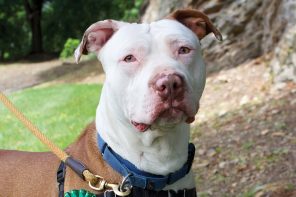One of the most important aspects of your relationship with your dog is to have open communication. When you have open communication, your relationship is free of frustration and feeling misunderstood, which leaves room for more enjoyable moments.
One area of having open communication with our dogs involves physical items, ones that are permitted for dogs, such as toys, chews and bones. This also applies to items our dogs may not be permitted to have but pick up, like socks, shoes, hair ties and maybe even the remote control. It is important to set the tone, build trust and diffuse conflict by not overreacting. We don’t want to add more fuel to the fire, so to speak.
I teach this idea of a healthy relationship between items and dogs simple. To have success in removing any sort of primal guarding, you have to do the daily work. I always begin with what I call “trading,” which leads to “sharing.”
Let’s start with an example of how I would begin training a new dog to “trade.” If I were to give your dog an item, like a bully stick or bone, I would then walk up to him with a relaxed and calm energy after a few minutes while he is invested in it, and gently place or softly drop a treat in the vicinity of where he is chewing. At first he may not even stop to use his nose and find the treat. He may not even acknowledge me. This is all part of the process. It is not meant to be a long, overdrawn “look at me” exercise. This is simply step one of many. This step of walking up to your dog from a public space, going all the way to an intimate space and gently placing or softly dropping a treat in his vicinity where he is chewing is meant to be practiced until he starts to acknowledge me on his own. He may even stop chewing. More and more over the course of practicing this exercise, your dog will start to look for you when you are arriving. This is the beginning of your dog starting to anticipate that someone walking up means good things will follow. I am still mindful of my energy, being calm and present, not talking a lot or trying to pet the dog. I am just focusing on step one.
After establishing step one with your dog, I can start working on giving the dog the treat from my hand instead of casually placing it next to him. I may also name this command by saying “take it.” During this second step, I may also place one next to the item he is chewing on, besides giving him the treat. The idea is for him to understand that when hands come into his intimate space, all is well and it’s not a big deal.
So many people give their dogs high-value items and once they are finished, it’s not a big deal. But a problem can arise when the dog is working on an item and the family has to leave the house and needs to take the item away for the dog’s safety. If this “trade training” is not practiced and mastered, someone who walks up to the dog to take away the item may experience a dog who could possibly snap or bite him. This is why the process I am explaining is so beneficial. We can eliminate the conflict if we practice building trust and open communication.

Here’s where step three comes in. Over time, after your dog has mastered steps one and two, he is going to be more interested in you than the item he is working on. The dog may drop the chew item a little sooner in anticipation of getting something from you. You may then give him a treat and then pick up the chew item he is working on and hand that item right back to him. This is part of the “sharing process.” This process is important to practice with your dog. In a nutshell, it’s the notion that your dog gets to have that high-value item back. He may not even want it back, but it isn’t about him taking it; it’s about you offering it back to him. This is building trust between you and your dog.
I like to explain it to humans like this: You have been working hard all day. You sit down to enjoy a veggie burger after not having eaten anything for a while. You go to take a bite of your burger and it melts in your mouth. It’s so satisfying. You go to take a second bite and right as you do, someone comes up to you and takes that burger away from you. If it were me, I would be agitated, confused and I would for sure say “what the f— are you doing?” Let’s change the story. Same beginning of eating a veggie burger and being on your second bite, so looking forward to it and someone comes up to you and hands you a side of sweet potato fries. Now that feels great. Then, that person comes back with an ice-cold beverage, ketchup and napkins. It feels like the greatest moment ever. I explain it this way so that humans are more likely to understand that showing kindness and being mindful of how we approach situations allows them to be exactly what we want them to be — stress free.
So back to trading. My goal is for you to get so good at the first two steps that no matter what item your dog has, you can walk over without overreacting to check it out. Because of the mastery of these two steps, the dog is able to share the item with you without hesitation or incident.
Read the rest of the article at wagmag.com
For more, contact Cristina at Trail Dog Inc., 914-755-1153.




